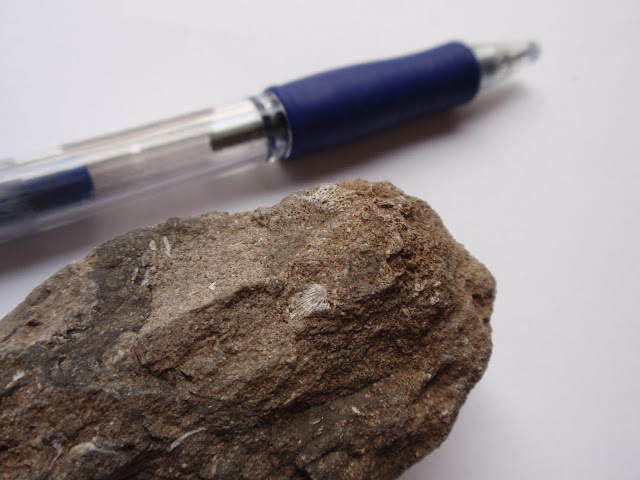Limestone is basically any sedimentary rock with plenty of calcium carbonate (CaCO3). The mineral (i.e. crystalline) form of calcium carbonate is calcite, of which I found a rather large, (fairly) pure example.
Calcite looks a lot like quartz (and a few other grey translucent minerals), but there is a (fun) way of making sure it is calcite. CaCO3 reacts with hydrochloric acid (HCl) to form water (H2O), a salt (CaCl2, which is dissolved in the water, so you can't see it) and gas (hydrogen gas H2
and carbon dioxide CO2) which escapes from the water as bubbles. So, if you pour a drop hydrochloric acid on the rock and it fizzles, there is surely carbonate in it.
As for the fossils, a few are less spectacular, such as the two brachiopods below (the second might be har do see from that angle, but to be honest, it is hard to see from any angle!).
I tend to find crinoids in large, disorganised masses, perhaps because they have been thrown around by strong currents.
It is a shame, because I find them rather adorable from time to time (even though I always only find bits of stalks...). Albeit not remarkably interesting anatomically, these buggers have their charm.
More to my current interests, I found a few rugose corals.
Where is the little coral there? Actually, I just noticed it when I was taking the picture. Let me zoom in for you.

Look at the part where it has been broken in two. The inward-facing groovey thingies are tell-tale signs that it is a rugose coral.
And here are finally some nice brachiopods.
The end.
Please understand why I cannot make too many elaborate posts. I would be happy to, but time needs to be budgeted, and so on.
However, for the mammoth field trip to the island of Arran in Scotland, I promise you an interesting story, if anything about surviving in a God-forsaken island that has recently sufferet from a long, heavy power-cutting snow storm, where the visitors were stranded because the ferries were cancelled. That of course does not stop hard-core geologists...




















